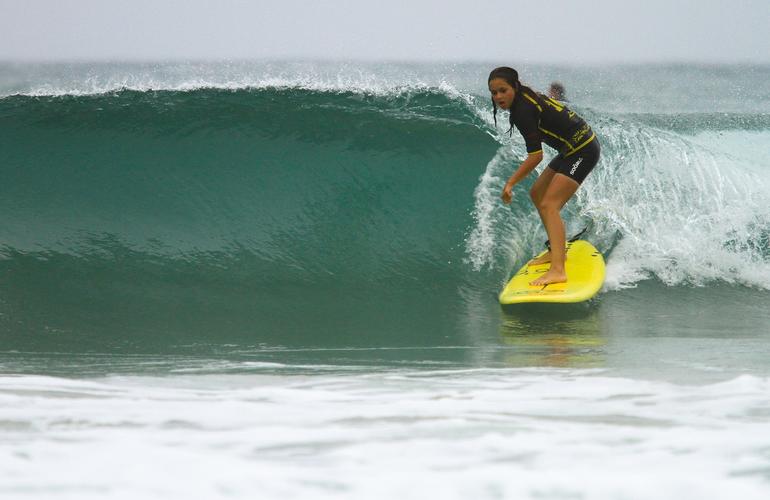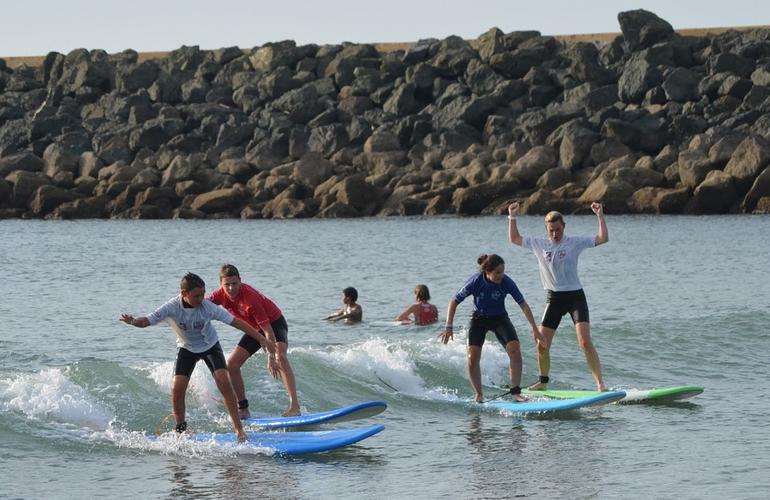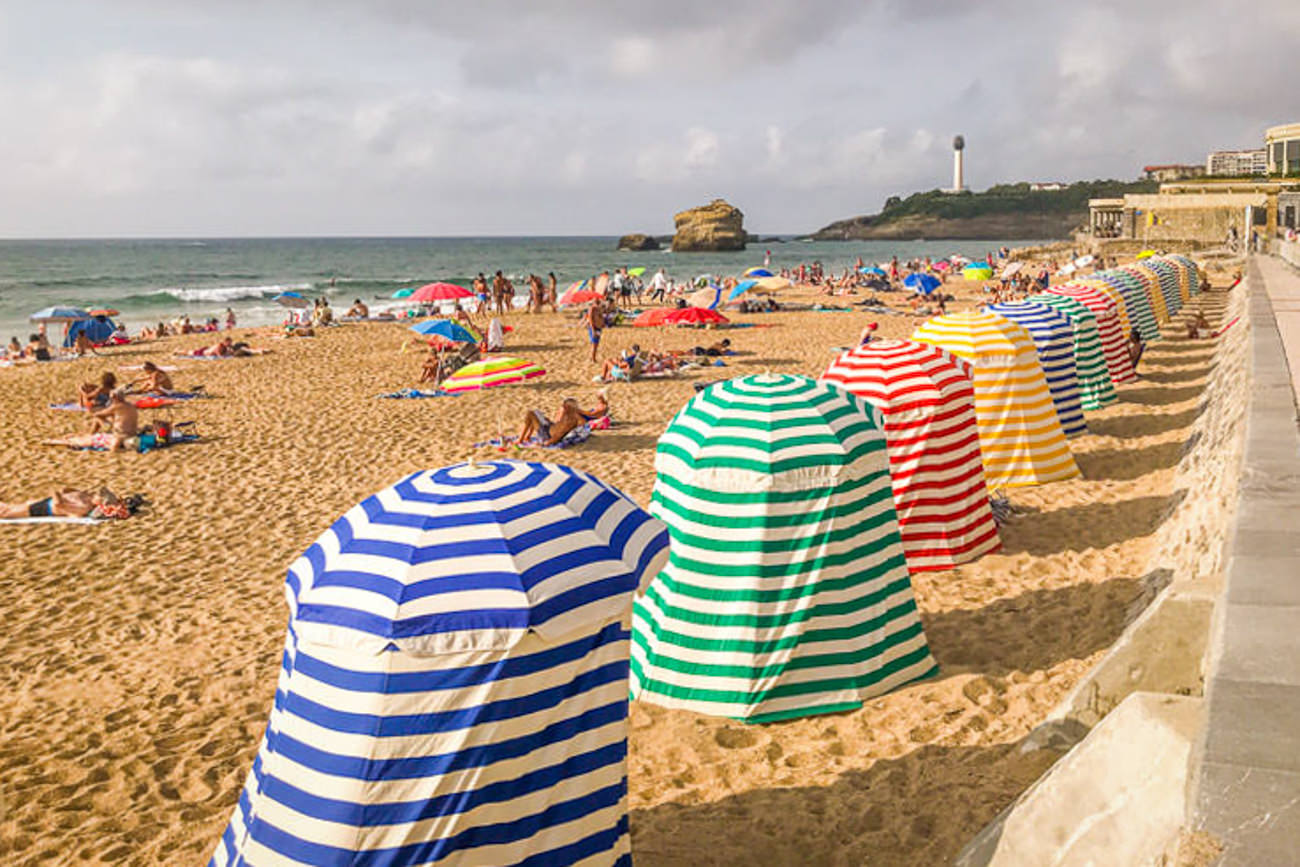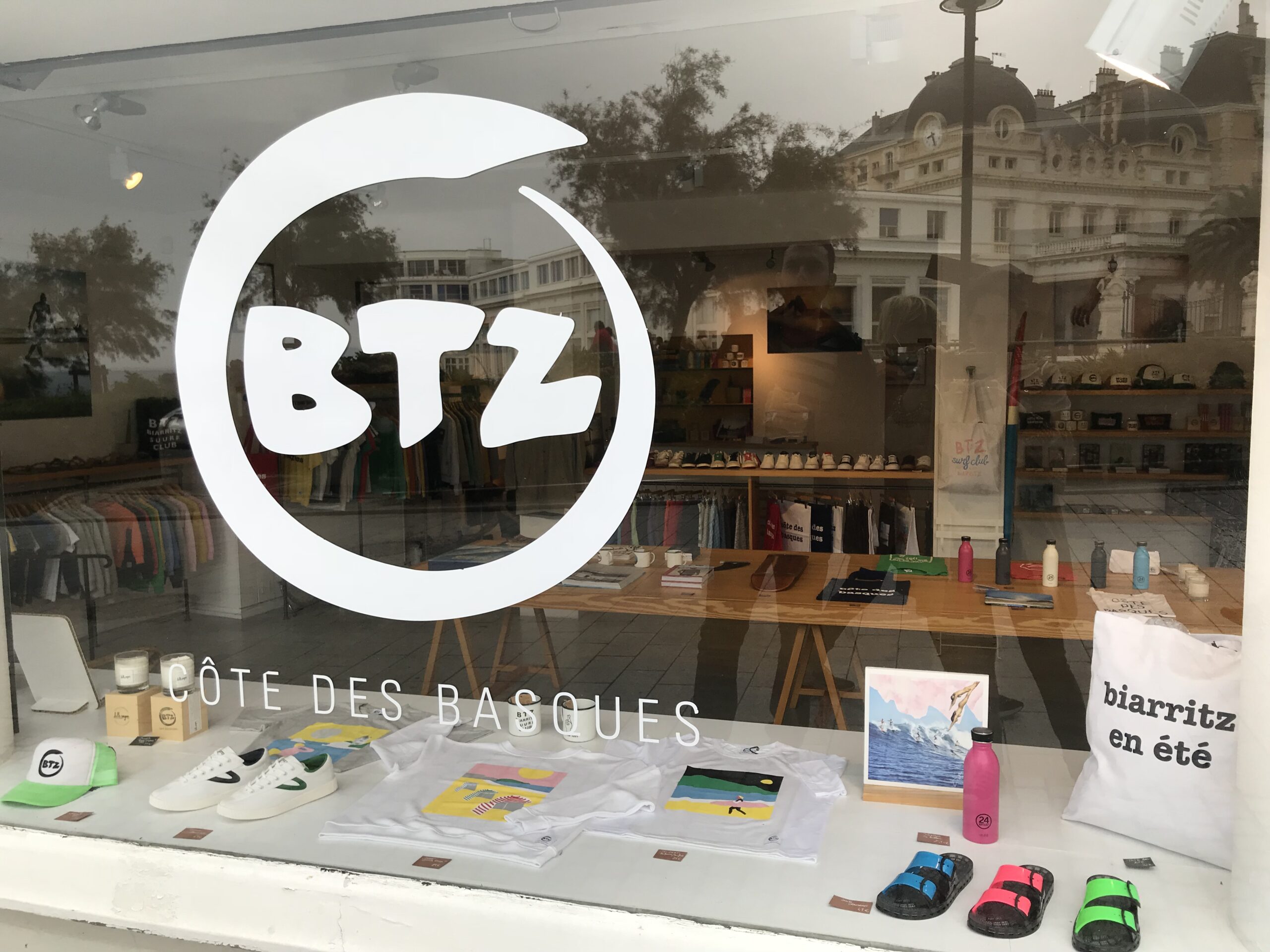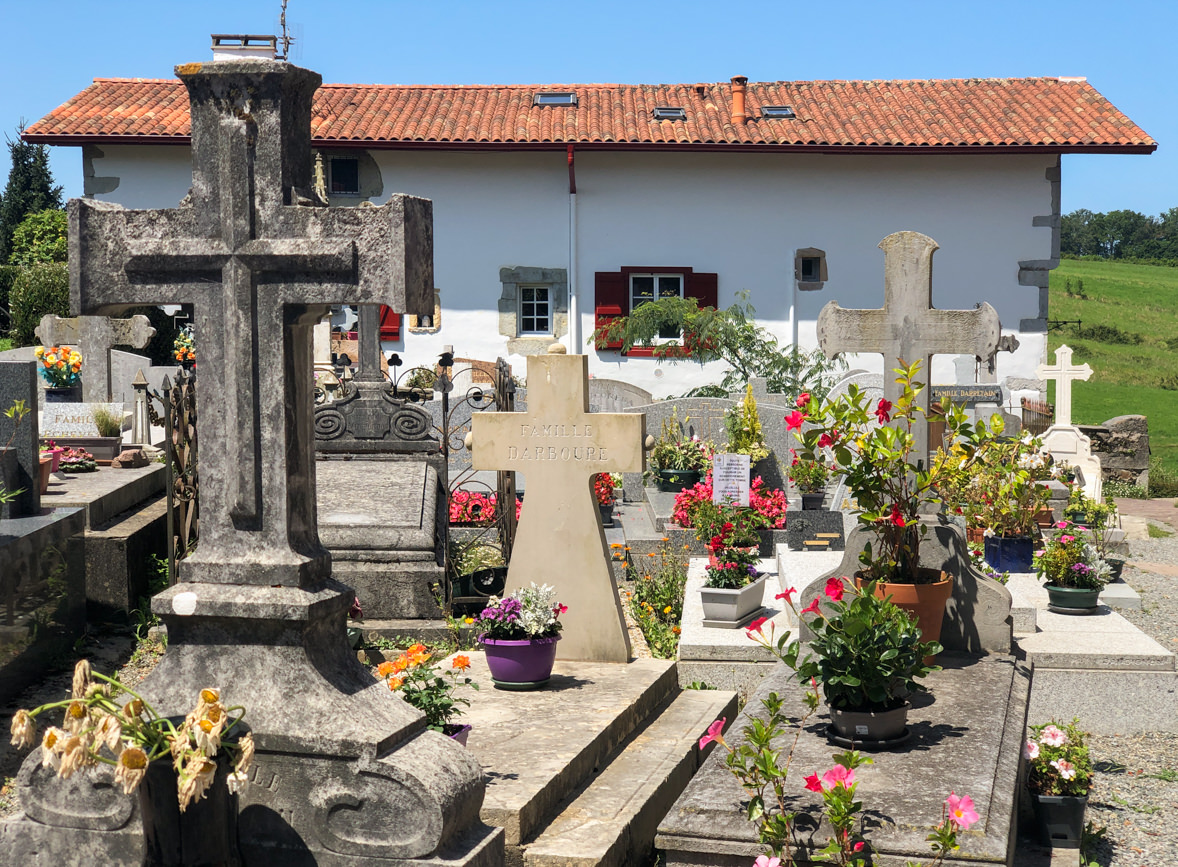
Itinerary around the French Basque Country
Nestled in between the Atlantic coast and the mountains, the French Basque Country (also known as Iparralde) features idyllic villages and landscapes. Located in the Nouvelle Aquitaine region, just across the border from Spain, I am sure you will fall in love with this area. Keep on reading to learn where to go, what to see and do throughout the coastal and countryside villages. Are you ready for this itinerary around the French Basque Country?
[Disclaimer: please note that this post includes some affiliate links. This means that, at no additional cost for you, I earn a commission if you make a purchase. In case you have any question about the companies advertised here or my status as an affiliate, please do not hesitate to contact me.]
For your ease of reference, I’ve broken down all the destinations in this itinerary around the French Basque Country between the coastal villages and the ones in the countryside. You can read the Basque name of each place in brackets for each destination.
At the end of this post, you will also find a map where I pinned all the locations mentioned here.
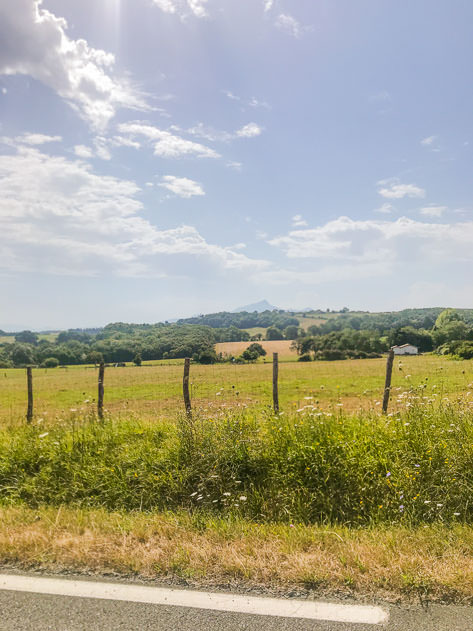
Coastal villages along the French Basque Country
We start this itinerary along the French Basque villages by the rugged Atlantic coastline right after crossing the border between Spain and France. I recommend you drive along the scenic route de la Corniche (road D912). The coastal villages below are mentioned in that order, from south to north, starting in Hendaye and heading towards Anglet. Note that many of the beaches along this itinerary are popular surfing destinations.
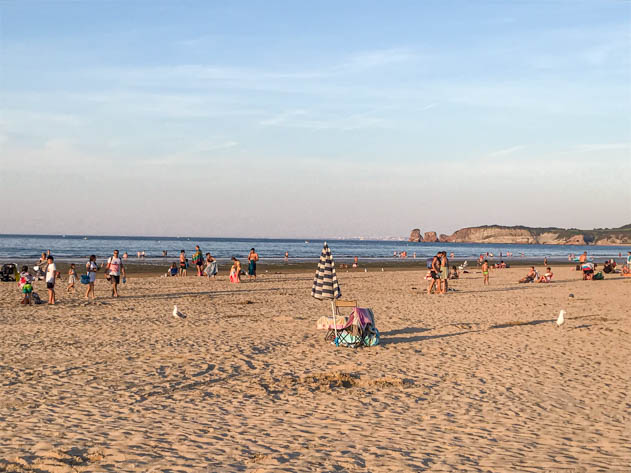
Hendaye (or Hendaia)
Hendaye is the first French city once you’ve crossed the Spanish border over the river Bidasoa that divides both countries. You can cross from two neighborhoods in Irún: Santiago or Behobia.
Hendaia is home to over 17.000 inhabitants. The city of Hendaye can be differentiated in two distinct parts: Hendaye Ville (the Old Town) and Hendaye Plage (the beach area).
In Hendaye Ville, the main highlights include the square (Place de la République) with the city hall (Mairie) and the church (église Saint-Vincent). Make sure to check the farmers’ market (marché) taking place here every Wednesday morning. A few steps away you will find the harbor (Port de Caneta), the fronton Gaztelu Zahar and a monument dedicated to the fallen of World War I overlooking the beautiful Txingudi Bay.
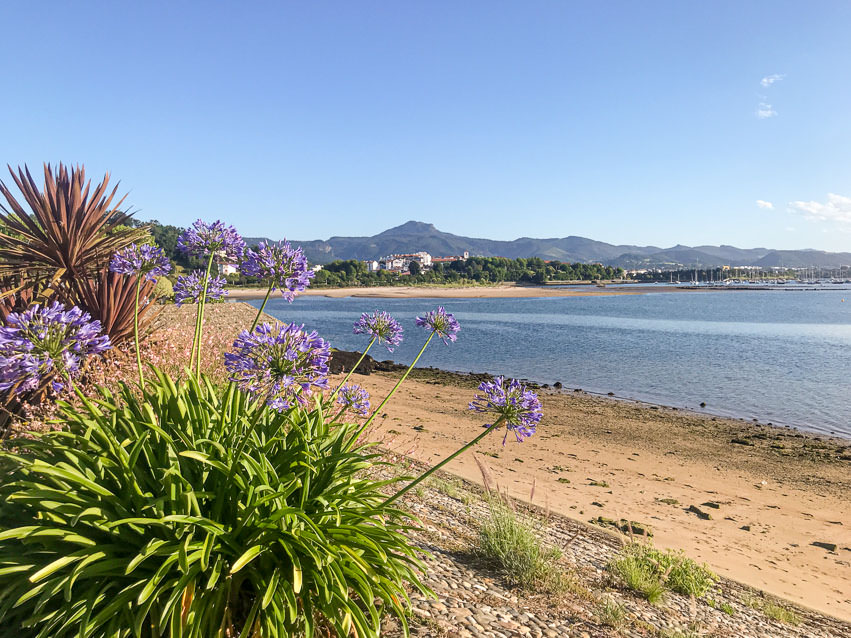
Following the promenade along the bay, you will reach Hendaye Plage. The obvious attraction in this area is the beach (Hendaye Plage). At the far right end of this 3 km long beach, you will notice two huge rock formations known as Les Deux Jumeaux. Kindly note that this part of the beach is nudist.
Other nearby points of interest include the marina (Port de Plaisance), the former Casino (a Moorish-looking building by the beach), the promenade by the Boulevard de la Mer and another church (église Sainte Anne). In addition to special markets and activities during the summer months in the beach area, another farmers’ market takes place in Sokoburu on Saturday mornings throughout the year.
Finally, when driving towards St Jean de Luz along the route de la Corniche, you will see the Château-Observatoire Abbadia, a great last stop in Hendaye before continuing your itinerary.
Hungry during your visit to this border city? Here are some suggestions of cafes and restaurants to eat in Hendaye:
- Chez Lolo: food truck with tacos and burgers close to the beach
- Croq’ Pizza: yummy pizzas on the way from the train station to the city center.
- Boulevard de la Mer and Place du Port: most restaurants and bars in the beach area of Hendaye are located here.
- Walter Glacier: renowned ice creams a few steps away from the old Casino and Hendaye Plage.
- La Gourmandise: delicious crêpes and waffles right in front of the beach. I typically go for a crêpe au Nutella.
- Philippe Roy: you will find this bakery directly before crossing over the Santiago bridge between Spain and France.
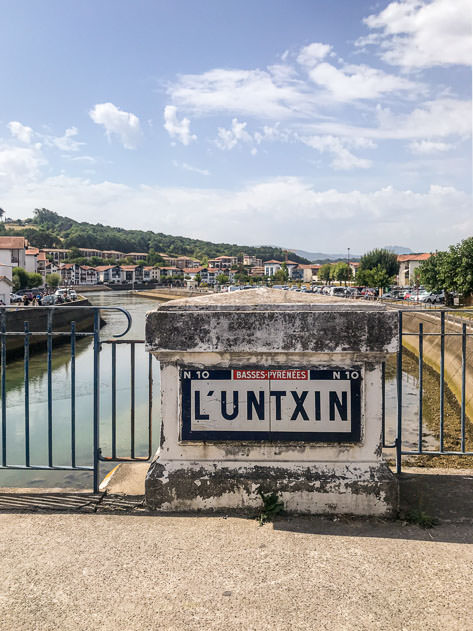
Ciboure (or Ziburu)
With around 6.000 inhabitants, Ciboure is a small village along the scenic route de la Corniche. My favorite spot here is the Socoa fortress (Fort de Socoa), built in 1627 in order to protect the port as well as the nearby bay of St Jean de Luz. Even though you won’t be able to visit the fortress, its strategic location offers a beautiful view of the rugged coastline and the adjacent city of Saint Jean de Luz.
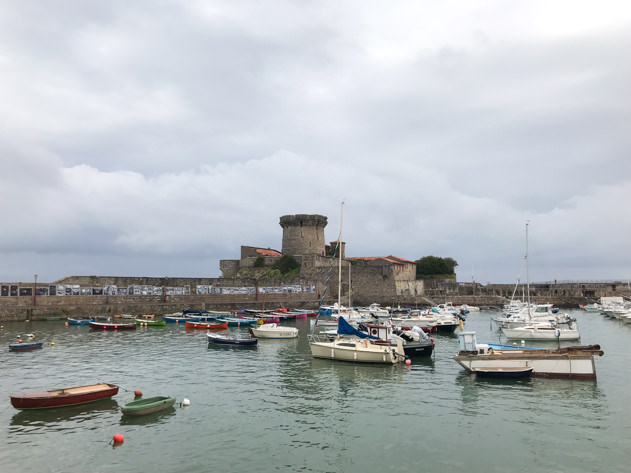
In addition to this historic landmark, other attractions in Ciboure include the house of musician Ravel (Maison Ravel) and various beaches (plage de Ciboure, plage de Socoa).
Along the Avenue du Commandant Passicot you will find various cafes and restaurants.
Read some of my posts about Ciboure !
Back home in September (part 2): Hendaye, Ciboure, Biarritz
Merry Christmas from home (part II)
Stories from back home and nearby
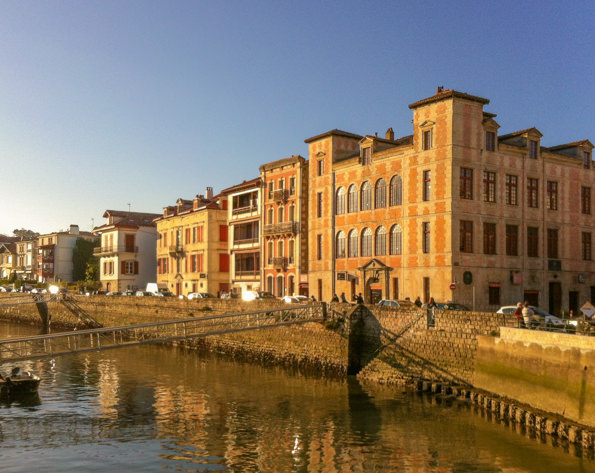
Saint Jean de Luz (or Donibane Lohizune)
Following the coastline, we arrive to St Jean de Luz. Fun fact: I studied here during high school, at the Lycée Maurice Ravel. 🙂
This historic town of around 14.000 inhabitants is particularly famous because the marriage between the French king Louis XIV and Maria Theresa of Austria took place here in 1660.
The following landmarks stand out when visiting Saint-Jean-de-Luz:
- Maison Louis XIV (also known as Lohobiague-Enea): located in the homonymous square, this house welcomed the King for several months in the 17th century while he waited for his wedding.
- Maison de l’Infante (or Joanenia): similarly, a nearby palace next to the port housed the Austrian princess before getting married to the French monarch.
- Port of Saint Jean de Luz: in this colorful harbor by the city center you will find fishing as well as recreational boats. The fish market is located nearby.
- Église Saint-Jean-Baptiste: this church is where the abovementioned royal marriage took place. Dating back to the 14th and 15th century, and located by the commercial rue Gambetta, the temple features an organ, an elaborate altarpiece and a miniature ship that hangs from the ceiling.
- Beaches: thanks to its strategic location by the seaside, Saint Jean de Luz slowly transitioned from being home to pirates and fishermen to a popular holiday resort. In addition to the Grande Plage steps away from the bustling city center, other beaches worth exploring include plage d’Erromardie and plage Lafitenia.
- In case you like walking, I suggest you stroll along the Grande Plage. To your left, you will reach the lighthouse (Phare de St Jean de Luz) after passing by colorful houses connected by bridges to the promenade Jacques Thibaud. On the other hand, if you head right when facing the beach and keep walking, you will find yourself up on the Sainte Barbe hill. It’s the perfect spot to enjoy a panoramic view of the Atlantic coast.
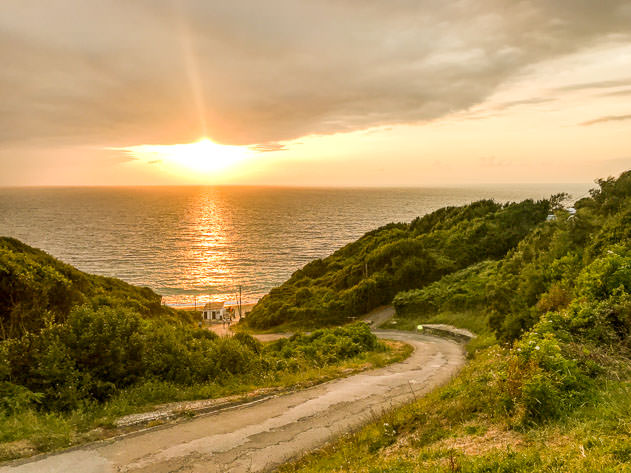
For shopping, make sure to stroll along the pedestrian rue Gambetta, where you will find various tempting shops: Maison Adam for delicious macarons, Marcel Travel Posters or Bayona for the traditional espadrilles to name just a few. If you’re curious about the fresh local products, explore the covered market of Les Halles. In case you’re into golf, you can visit the nearby Chantaco golf course.
Finally, here are some accommodation options if you decide to sleep in St Jean de Luz. While Grand Hôtel Thalasso & Spa and La Réserve are on the expensive side, you can filter cheaper hotels and apartments on Airbnb or Booking.
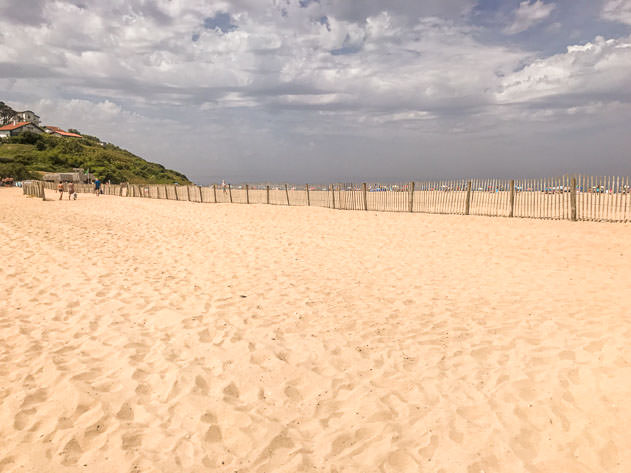
Guéthary (or Getaria)
Not to be mistaken with Getaria further along on the Spanish Basque coast, this village on the French Basque side is divided in two parts by the main road that crosses it.
The upper part revolves around the church (église Saint-Nicolas) and its surrounding cemetery, but the main sites in Guéthary lie in the lower district, closer to the ocean. It’s a steep walk though and you may want to rent a tuk-tuk to take you around.
In the center of Guéthary you will find the city hall next to a fronton, elegant villas as well as an art museum (Musée Saraleguinea de Guéthary). The most iconic spot is the cozy small harbor (le vieux port).
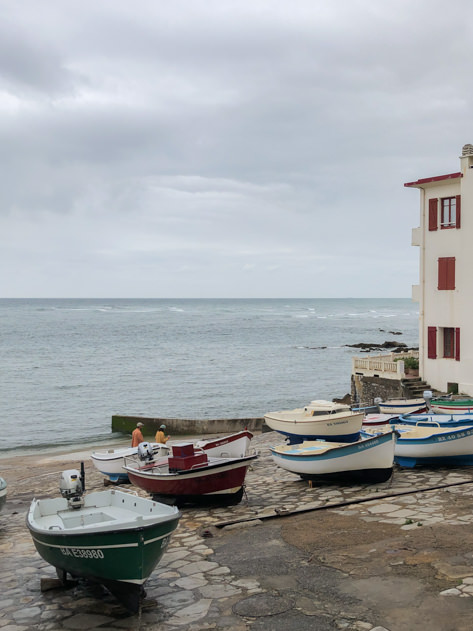
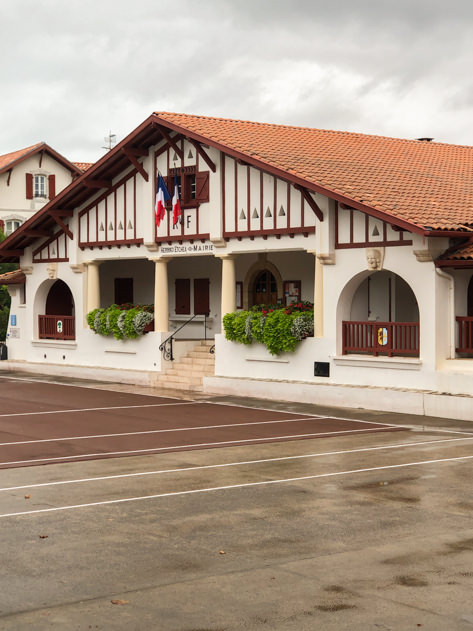
Don´t forget to check out the various beaches in Guéthary: Parlementia and Senix.
Not sure where to stay in Guéthary? Hôtel Balea or Le Madrid are among the accommodation options, but you’re welcome to browse Airbnb and Booking for more.
Last but not least, have a drink or eat a bite at Hétéroclito, Le Madrid or Les Alcyons to enjoy unforgettable views of the French Basque coastline.
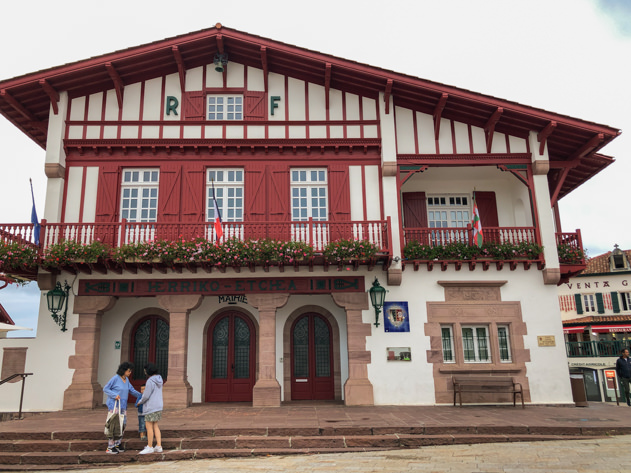
Bidart
Bidart is a rather small village along the French Basque coast. Although it can be explored in an hour or so, it is worth taking your time to fully embrace the slow pace of life.
You can start your visit to Bidart in the main square (place Sauveur Atchoarena), where you will find the usual suspects: the city hall, a church (Église Notre-Dame de l’Assomption) and a fronton (Petit Fronton). A bigger one (Grand Fronton) can be found steps away. Located around the square are various bars, cafeterias, restaurants and hotels. A few chapels are also scattered throughout Bidart: chapelle Sainte-Madeleine, chapelle Ur Onea and chapelle Saint-Joseph.
Furthermore, Bidart has become a popular summer destination thanks to its beaches (plage d’Ilbarritz guarded by the homonymous castle, plage du Centre, plage Erretegia and plage du Pavillon Royal).

Biarritz
Biarritz is probably the most famous and glamourous city in the French Basque Country. Given its strategic location by the sea, Biarritz quickly emerged as a popular spa destination in the 19th century. The British Royal Family spent some periods of time here and the French Empress Eugenia, wife of Napoleon III, also ordered the construction of her summer residence in the city (nowadays it has been transformed into the luxurious Hôtel du Palais).
The main sites to visit in Biarritz include the following: the traditional port (Port des Pêcheurs), the church dedicated to Sainte-Eugénie, the lighthouse (Phare de Biarritz – enjoy panoramic views after going up the stairs), small islands connected to the mainland (Rocher du Basta, Rocher de la Vierge), Casino Barrière if you’re feeling adventurous and the market (Les Halles).
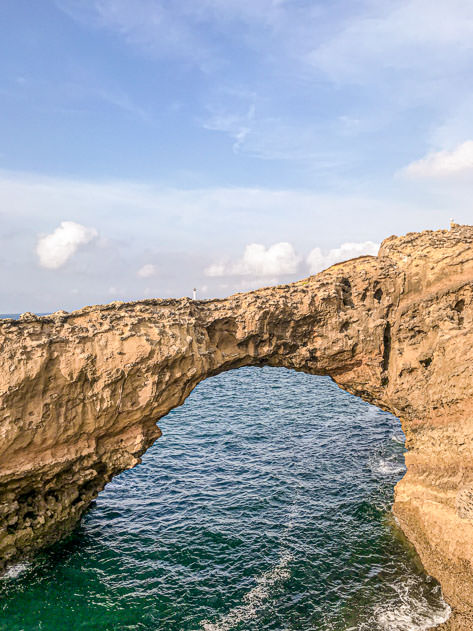
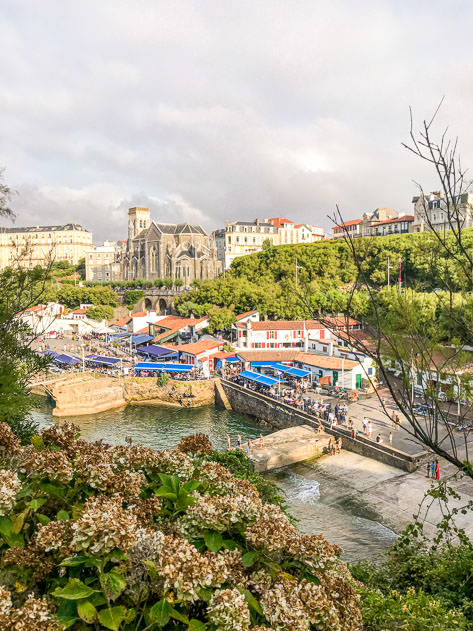
As you can imagine, Biarritz counts with various beaches: although the most popular is La Grande Plage (it tends to be packed in the summer), you can explore others such as Plage Marbella, Plage Miramar, Plage du Port Vieux, Côte des Basques and Plage de Milady.
Feeling adventurous? Check out these Manawa activities in Biarritz.
Day trip by boat from Biarritz
Helicopter flight experience in Biarritz
Kayak-surfing session near Biarritz
Surfing lessons and courses in Biarritz
When it comes to eating in Biarritz, one of my favorite spots is a crêpe au Nutella at Le Blé Noir. You will find many traditional restaurants in Port Vieux offering fresh fish and seafood. In case you’re looking for a cheaper option, you can always stop by Les Halles to buy some local products at the market and eat them somewhere with a view.
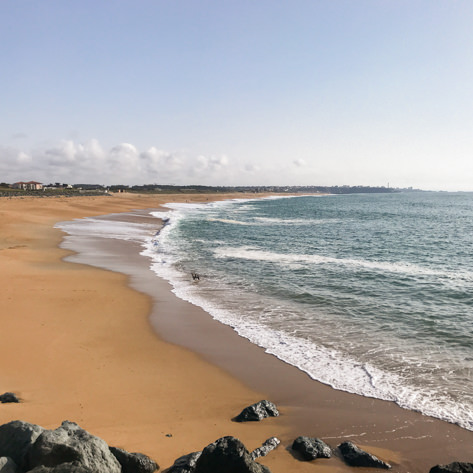
Anglet
Right next to its famous neighbors Biarritz and Bayonne, Anglet is a destination that may go unnoticed. However, this city housing over 40.000 inhabitants offers some surprises.
First of all, its 4.5km long promenade by the Atlantic Ocean is worth mentioning, with endless beaches following one after another: Plage de la Barre, Plage des Cavaliers, Plage des Dunes, Plage de l’Océan, La Madrague, Les Corsaires, Plage de Marinella, Plage des Sables d’Or and Plage De La Chambre D’Amour. As you can see, there are a lot of beaches to choose from!
Feeling adventurous? Check out this Manawa activity in Anglet.
5-day surfing course in Anglet
If you head inland, you’ll find the city center. A vast part of Anglet is covered by the Chiberta forest. You can also enjoy nature in two lakes: lac de Chiberta and lac du Boucau.
Finally, if you like playing golf, you’ll be happy to discover Golf de Chiberta, that encompasses a 4-star hotel.
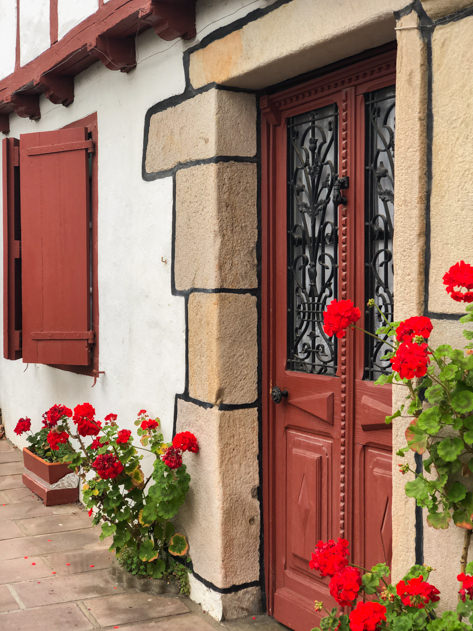
Countryside villages in the French Basque Country
Below you will find a brief description of my favorite locations in the French Basque countryside, sorted in alphabetical order.
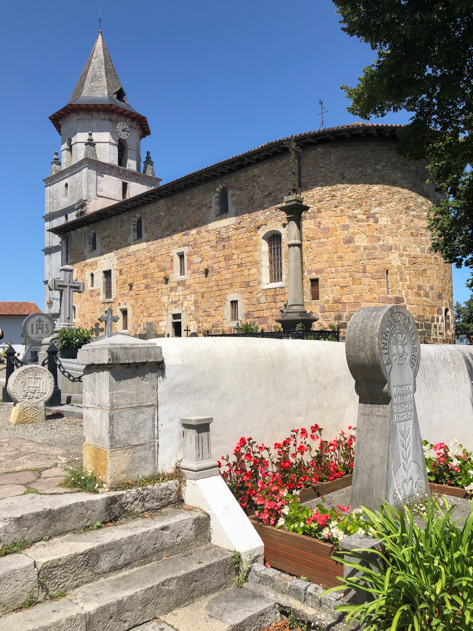
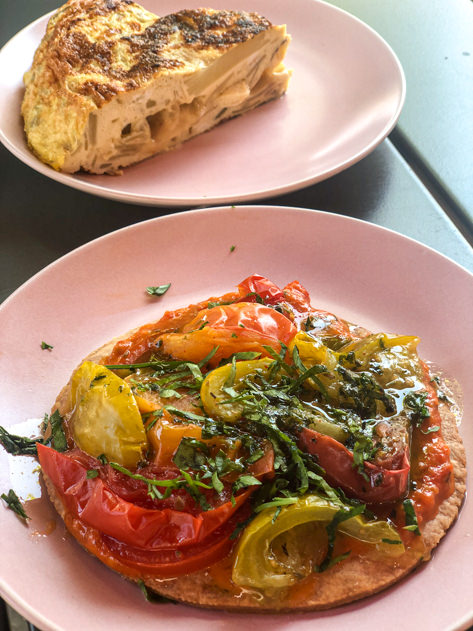
Ainhoa
Our first stop in the itinerary around the French Basque countryside is in Ainhoa, a tiny village full of charm. By the way, Ainhoa is also a very common female name on both sides of the border.
Walk along the main street (Qur Karrika) in a circle to find the main highlights of Ainhoa: the church (Eglise Notre-Dame de l’Assomption) surrounded by the cemetery and the fronton, as well as a chapel (Chapelle Saint-Joseph). Other attractions include the old washing place (lavoir d’Ainhoa) and a trail connecting with neighboring Spain that was used for smuggling purposes back in the day (route des contrebandistes).
Most bars and restaurants can also be found in this area, featuring these foodie recommendations:
- Krakadak: fantastic restaurant with outdoor seating overlooking the main street of Ainhoa and serving yummy local specialties. The last time I visited with friends, we ordered a Spanish omelette, a tomato pie (tarte fine avec tomates) and a casserole dish of peppers with ham and fried eggs (kaxuelita d’amatxi). For dessert, we had an apricot tartelette and the famous Basque pie with cherries (gâteau basque avec cerise). We loved this place!
- Ithurria: this restaurant with a Michelin star offers delicious Basque cuisine. You can stop by their bistrot for a more informal lunch or book a room at the family-run hotel.
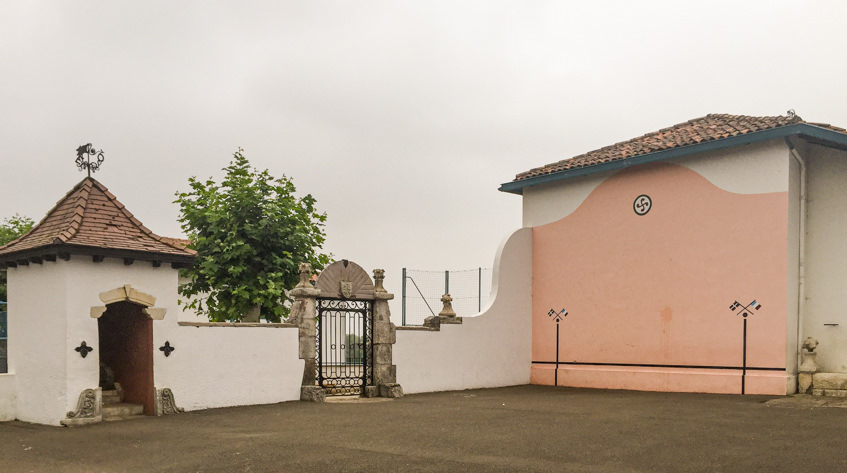
Arcangues (or Arrangoitze)
With a population of over 3.000 inhabitants, Arcangues is the ideal Basque village. Set on top of a valley, the slow life here revolves around the Place du Fronton, surrounded by the church dating from the 18th century (Eglise Saint-Jean-Baptiste de l’Uhabia), the cemetery overlooking the nearby Golf d’Arcangues, the City Hall, the Tourist Office and a building designed to house the social events of the village featuring exquisite paintings and a wooden ceiling (Théâtre de la Nature Pierre d’Arcangues).
By the way, if you’re walking around the cemetery of Arcangues, you might notice the tomb of a distinguished guest. The Spanish singer Luis Mariano, very famous during his exile in France in the 50s, lies here.
Steps away from the village you will find the Château d’Arcangues. What you see nowadays is the third reconstruction of the castle, which was first built back in the 12th century and has belonged to the Lords of Arcangues since then. Currently, the ‘château‘ is used for private events such as weddings or conferences.
In case you’re hungry while visiting Arcangues, you can try the following restaurants: Auberge d’Achtal, Restaurant du Trinquet d’Arcangues or Moulin d’Alotz.
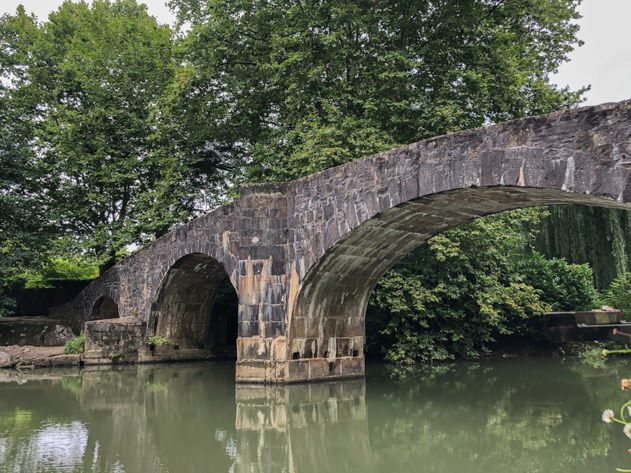
Ascain (or Azkaine)
This small village revolves around the main square, lying next to the church (Église Notre-Dame-de-l’Assomption), the nearby cemetery and the Town Hall (Herriko Etxea). Walk along the river Nivelle to discover the Roman bridge (pont romain; there’s a parking nearby), a mill and various frontons.
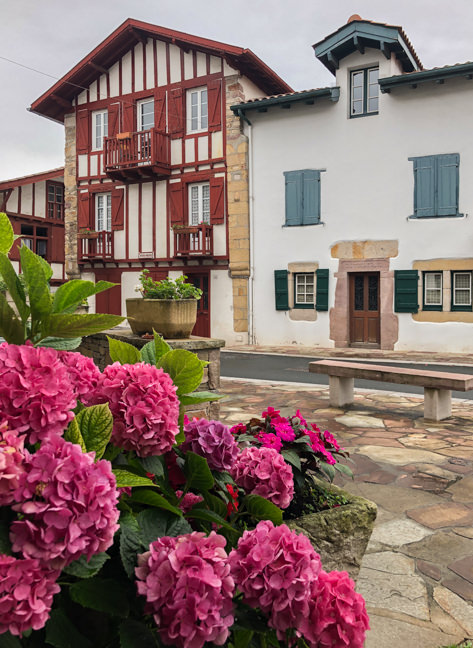
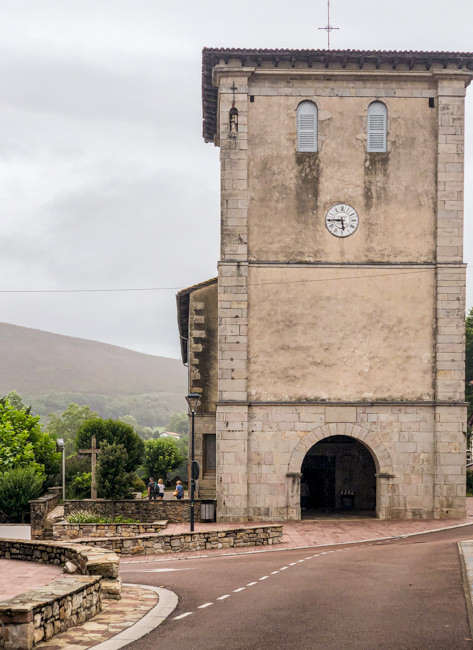
Watch this reels featuring Ascain, Sare, Guéthary and Bidart as a sneak peek of what awaits you in the French Basque Country!
Wondering where to eat in Ascain? Head to restaurant Larralde or restaurant des chasseurs. For those with a sweet tooth, you will find patisserie heaven at l’Atelier de Manu. In case you’d prefer to buy foie gras or any related product, Le Confit d’Ascain is your place to go.
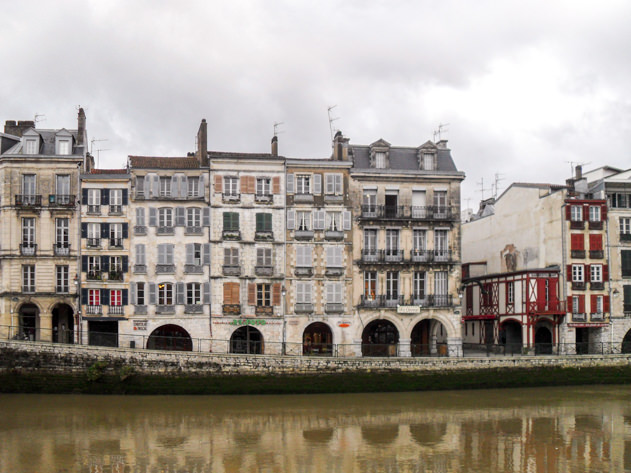
Bayonne (or Baiona)
Located at the confluence of the Nive and Adur rivers, Bayonne is the capital and the biggest city in the French Basque Country, also known as Iparralde. Given its importance, it has quite a few things to see and do. I suggest you start your itinerary exploring the old quarter of Grand Bayonne. When walking around its narrow medieval streets, you will find the Gothic Bayonne Cathedral featuring a wonderful 13th-century cloister. The nearby castle (Château-Vieux), the former city walls (remparts de Bayonne), defensive towers (such as the Tour Vieille-Boucherie) and gates (Porte d’ Espagne) will make you step back in time. Moreover, the Botanical Garden and the City Hall (Mairie de Bayonne) are worth checking out.
Across the Nive River, in the Petit Bayonne neighborhood, you may visit the Musée Basque et de l’histoire de Bayonne, a museum dedicated to the art, crafts and traditions of the region. A few streets away, you can explore the new castle (Château Neuf).
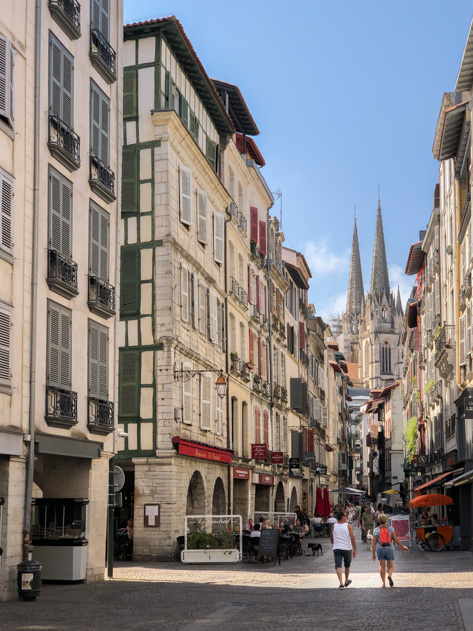
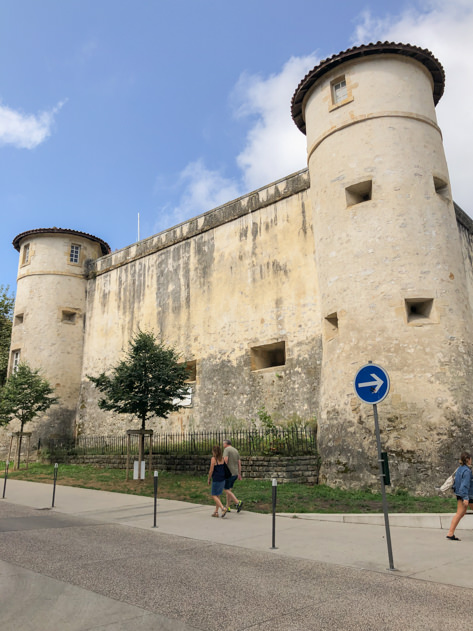
In addition to walking around the Grand and Petit Bayonne, you could also cross the Adur river and head to the Saint-Esprit area. The citadel (La Citadelle) overlooks this neighborhood, while the Chocolate Museum is an interesting stop.
If you’d like to bring a souvenir back home, chances are you’ll find something along the many shops in the commercial streets of rue d’ Espagne or rue Thiers.
As you know, food is an essential part of any trip for me, so here are a few suggestions of cafeterias and restaurants that you should try in Bayonne:
- Mokofin: delicious and delicate patisserie sitting next to the old castle
- Pâtisserie Lionel Raux: another cake shop recommended by a local friend of mine
- Chocolat Cazenave: Bayonne has a reputation for chocolate, and this cafeteria is one of its meccas. Having a cup of their foamy hot chocolate (mousseux) under the glass dome is a must!
- À la Bolée: this crêperie is a great spot for tasting yummy salty and sweet crêpes. Don’t forget to order their handmade cider!
- Kulunka: pleasant bar by the Adur river with a view to the citadel
- Bouillon Armand: this brasserie located in Petit Bayonne offers French traditional cuisine
- Les Halles: in case you want to cook yourself, this covered food market is a popular destination for locals and visitors looking for fresh produce. For instance, you may try the famous ham (jambon de Bayonne), although being Spanish I’m obviously biased for our very own jamón serrano. 🙂
Last but not least, Bayonne is well known throughout France because of its ‘Fêtes de Bayonne‘. Inspired by the famous San Fermines in Pamplona (Spain), thousands of people gather in Bayonne for five days at the end of July to celebrate a colorful festival filled with traditional music and dance. You might be surprised to learn that, like in many southern cities of Spain such as Sevilla or Málaga, locals here love bullfights and even have their own bullring (Arènes de Bayonne).
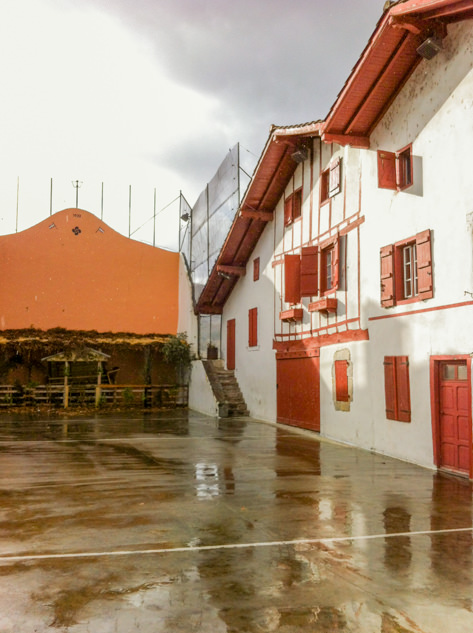
Biriatou (or Biriatu)
The tiny village of Biriatou, home to around 1.000 inhabitants, is located just across the river Bidasoa and a few minutes away from the nearby Spanish border.
The main highlights here include the church (église Saint Martin), the fronton and the City Hall. Around the village area, you will also find the remnants of a small fort built between the 18th and 19th century, known as Redoute Louis XIV, as well as cromlechs, dolmens and tumulus.
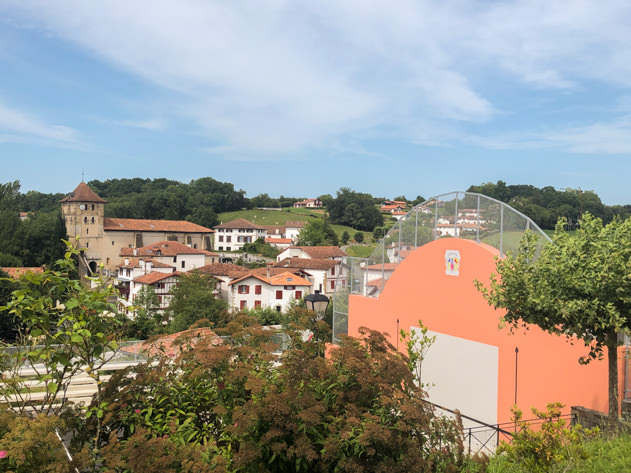
Espelette (or Ezpeleta)
Following with our cute villages around the French Basque countryside, Espelette ranks high on the list. Known for its red peppers (piments d’Espelette), you’ll see them hanging pretty much on any façade.
Start your visit to Espelette by parking for free next to the museum (Centre d’interprétation du Piment d’Espelette AOP), then go for a walk along the main commercial streets (Merkatu Plaza, Plazako Karrika). You’ll find plenty of options to buy local souvenirs here, from handmade espadrilles to cheese or pâté with Espelette pepper.
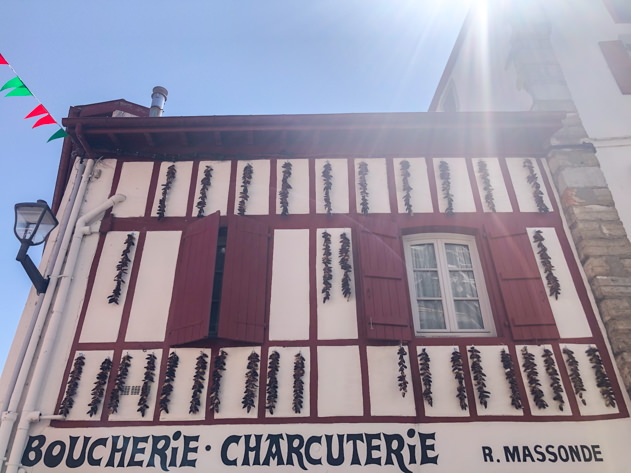
If you follow Plazako Karrika downhill and keep going under the bridge, you’ll reach the Catholic church of Église Saint Etienne. Built in the 17th century, this historic building has been restored over time. In case the church is open, I suggest you take a look inside and go up the various floors to admire the wooden galleries and the elaborate altarpiece. As usual in the French Basque Country, the cemetery surrounds the church.
Finally, you may stop at the former castle belonging to the Ezpeleta barons, which now serves as the City Hall, tourist office and library. Next to it lies the pastel fronton that overlooks the village.
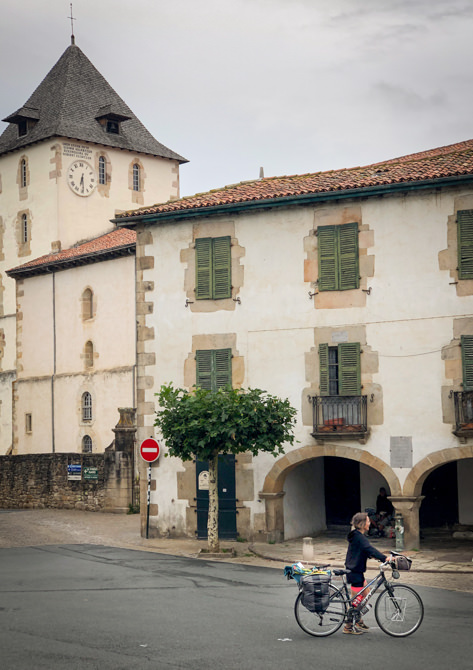
Sare (or Sara)
Last on our itinerary around the French Basque Country is the village of Sare, considered one of the most beautiful in France.
In case you’re looking for a place to stay in Sare, feel free to check out Hôtel Arraya. In addition to accommodation, this hotel also includes a bar and a restaurant.
As you might be guessing, a great starting point for your visit to Sare would be the church (Église Saint-Martin) that is surrounded by the cemetery. Next to them lies an intersection of streets, around which you will find the City Hall as well as several bars, restaurants and bakeries. Make sure to try the traditional Basque cake (gâteau basque), made of flour, butter, eggs and filled with pastry cream or some other seasonal fruits, typically cherries or apricots.
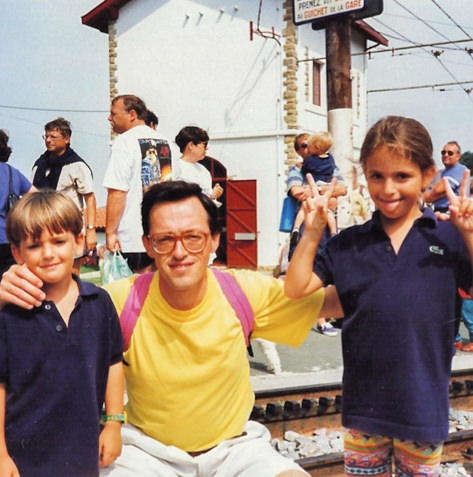
Moreover, you can explore the nearby caves (grottes de Sare), visit Ortillopitz to learn more about the Basque culture in a traditional house or take the cable railway to the top of Mont La Rhune at 905 meters high. The latter is a popular attraction in this area and you’ll enjoy panoramic views of both the Basque countryside and coastline. Alternatively, you can hike!
Last but not least, from Sare you can discover the Spanish region of Navarra, the closest villages on the other side of the border, also called ‘muga‘ in Basque, being Bera, Etxalar and Zugarramurdi.
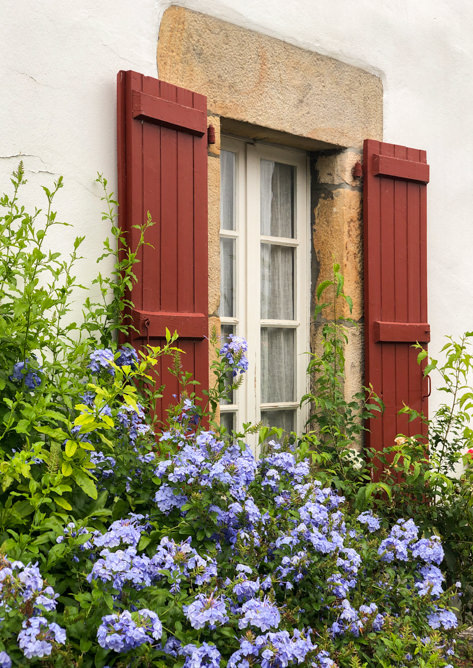
Map to follow my itinerary around the French Basque Country
Make sure to save the map below, as it includes all the locations mentioned throughout this post. The coastal villages along my French Basque Country itinerary are shown in blue, while the countryside destinations appear in green.
Find more inspiration in the French region of Nouvelle-Aquitaine!
The perfect summer day trip: Guéthary & Biarritz
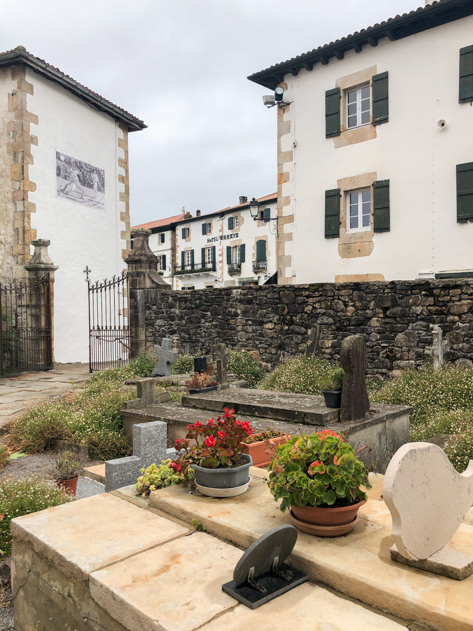
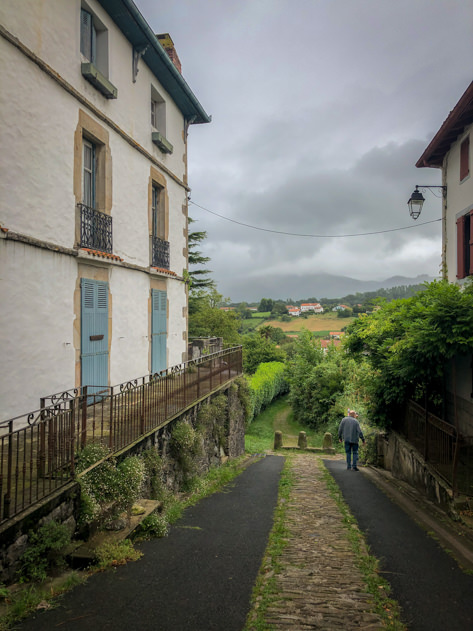
Tips for visiting the French Basque Country
Here are some recommendations when planning your trip to this southwestern area in France.
- In all Basque villages you will run into these distinctive architectural features: a city hall (Mairie or Herriko Etxea) surrounded by a church, a cemetery and a fronton (where locals like to play ‘pelota‘ games), as well as a bar (known as ‘taberna‘) and colorful half-timbered or stone-built houses, typically with wooden touches painted in red, blue or green.
- The French Basque Country is a popular summer destination thanks to its beaches and natural wonders, meaning it can get packed with tourists. If you can, try to avoid the busiest period of the year in Europe (July and August).
- Note that, in addition to French, people in the French Basque Country also speak the Basque language. Although it is similar to what is spoken across the border (in the Spanish Basque Country and in Navarra), the French dialect varies in its pronunciation and spelling of many words.
- Weather in this area of France is rather unpredictable and it tends to rain quite often. That is why our landscapes feature this lush green! Hence, make sure to pack an umbrella and a raincoat together with a swimsuit and flip flops. You never know what you’re going to get in the French Basque Country! 🙂
- Try the traditional food: from local cider to cured ham (jambon de Bayonne) and from delicious Basque cakes (gâteaux basques) to delicate macarons. The Basque Country is a paradise for foodies!
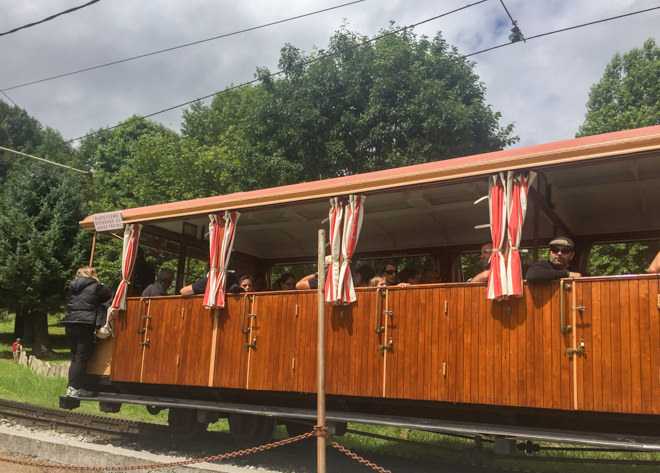
I trust you enjoyed my suggested itinerary around the French Basque Country after reading this post. Have you visited any of these coastal or countryside villages? Which one was your favorite? Please drop me a line if you come visit the area and / or need further tips.

